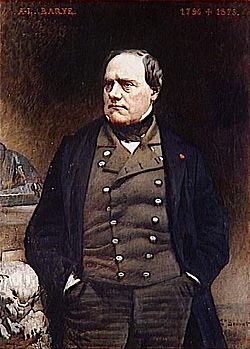Antoine-Louis Barye
| Antoine-Louis Barye | |
|---|---|

Portrait by Léon Bonnat
|
|
| Born |
24 September 1796 Paris, France |
| Died | 25 June 1875 |
| Education | École des Beaux Arts |
| Occupation | Sculptor |
| Parent(s) | Pierre and Marguerite Barye |
Antoine-Louis Barye (24 September 1796 – 25 June 1875) was a French sculptor most famous for his work as an animalier, a sculptor of animals.
Born in Paris,France, Barye began his career as a goldsmith, like many sculptors of the Romantic Period. He first worked under his father, Pierre, but around 1810 worked under the sculptor Guillaume-Mertin Biennais, who was a goldsmith to Napoleon. After studying under sculptor Francois-Joseph Bosio in 1816 and painter Baron Antoine-Jean Gros, he was (in 1818) admitted to the École des Beaux-Arts. But it was not until 1823, while working for Fauconnier, the goldsmith, that he discovered his true predilection from watching the animals in the Jardin des Plantes, making vigorous studies of them in pencil drawings comparable to those of Delacroix, then modelling them in sculpture on a large or small scale.
In 1819, while he was studying at the École des Beaux-Arts, Barye sculpted a medallion named Milo of Crotana Devoured by a Lion, in which the lion bites into Milo's left thigh. Milo's theme was the school's official theme for the medallion competition of 1819, where Bayre earned an honorable mention. Around 1820 Bayre sculpted Hercules with the Erymanthean Boar, depicting Hercules during his fourth Labor, where he had to capture, live, a wild boar from Mount Erymanthos.
Barye sculpted the portrait medallion Young Man in a Beret (1823) in bronze, as well as Portrait of the Founder Richard in 1827, in which only a head and neck are shown. He also sculpted Poised Stag in 1829, a much larger sculpture, which had a height of 48 cm, and was one-third of life size.
Barye didn't only want to be known as a sculptor of small bronzes, he wanted to be known as a sculpteur statuaire (a sculptor of large statues). In 1831 he exhibited much larger statues, Tiger Devouring a Gavial Crocodile which was a plaster sculpture 41 cm high and 103 cm long, and Lion Crushing a Serpent, 138 cm high and 178 cm long, made in bronze. In 1832 had mastered a style of his own in the Lion and Snake.
...
Wikipedia
